Analysis of Assessment Principles for Health and Safety Training in UK
VerifiedAdded on 2022/08/14
|13
|2473
|16
Report
AI Summary
This report examines the principles of assessment within the context of health and safety training for learners in the United Kingdom. It analyzes the importance of valid, reliable, sufficient, authentic, and current assessment methods in specialized teaching practices. The report provides a detailed overview of various assessment types, including pre-assessment, formative, summative, and others, outlining their purposes, benefits, and limitations through a comprehensive table. Furthermore, it evaluates the effectiveness of specific assessment methods in meeting the needs of learners, particularly within the context of observed teaching practice sessions. The report also references relevant legislation and guidelines, such as the Health and Safety at Work Act 1974, to provide a comprehensive understanding of assessment in health and safety training. The conclusion emphasizes the importance of utilizing appropriate assessment methods to ensure effective learning outcomes and a safe training environment.
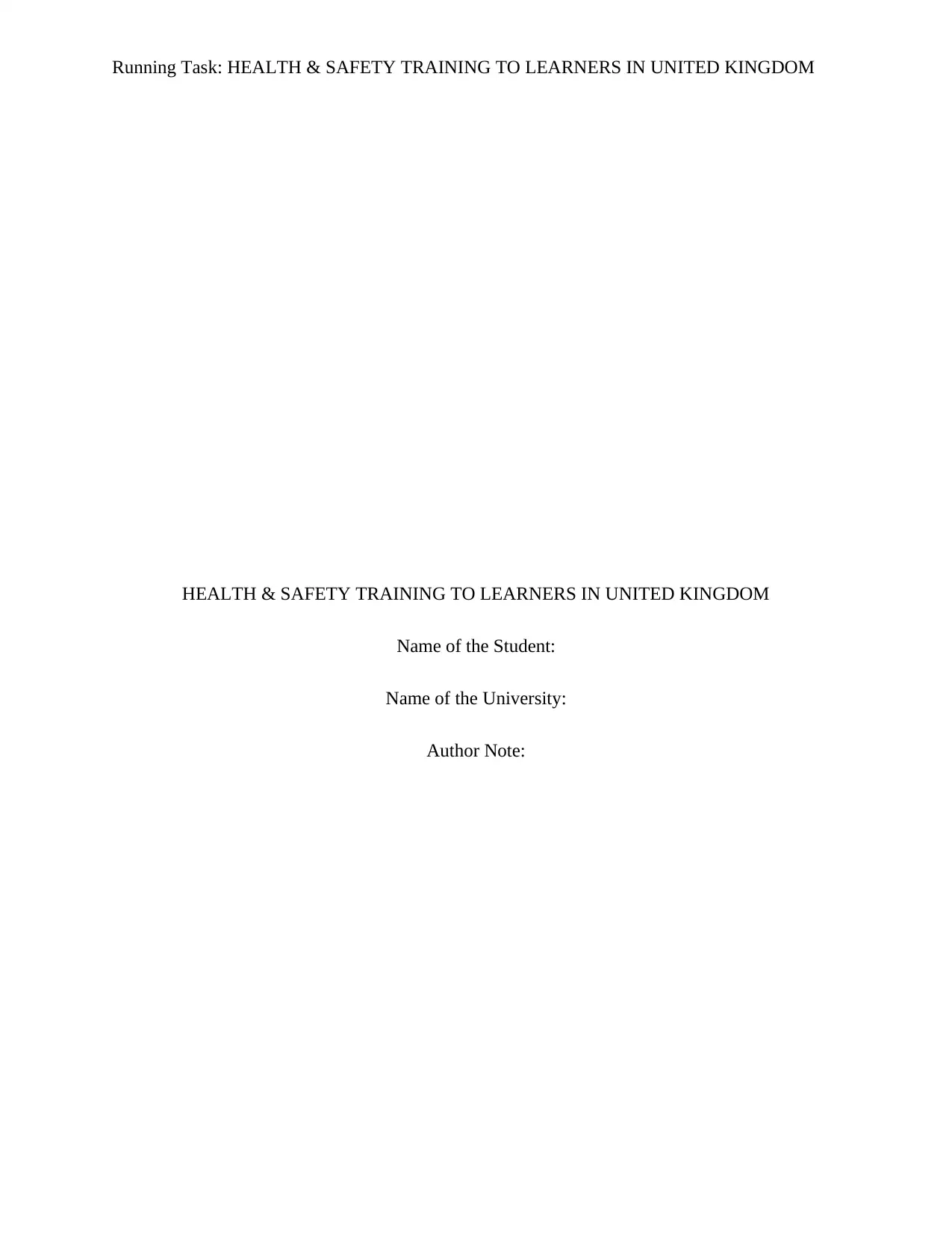
Running Task: HEALTH & SAFETY TRAINING TO LEARNERS IN UNITED KINGDOM
HEALTH & SAFETY TRAINING TO LEARNERS IN UNITED KINGDOM
Name of the Student:
Name of the University:
Author Note:
HEALTH & SAFETY TRAINING TO LEARNERS IN UNITED KINGDOM
Name of the Student:
Name of the University:
Author Note:
Paraphrase This Document
Need a fresh take? Get an instant paraphrase of this document with our AI Paraphraser
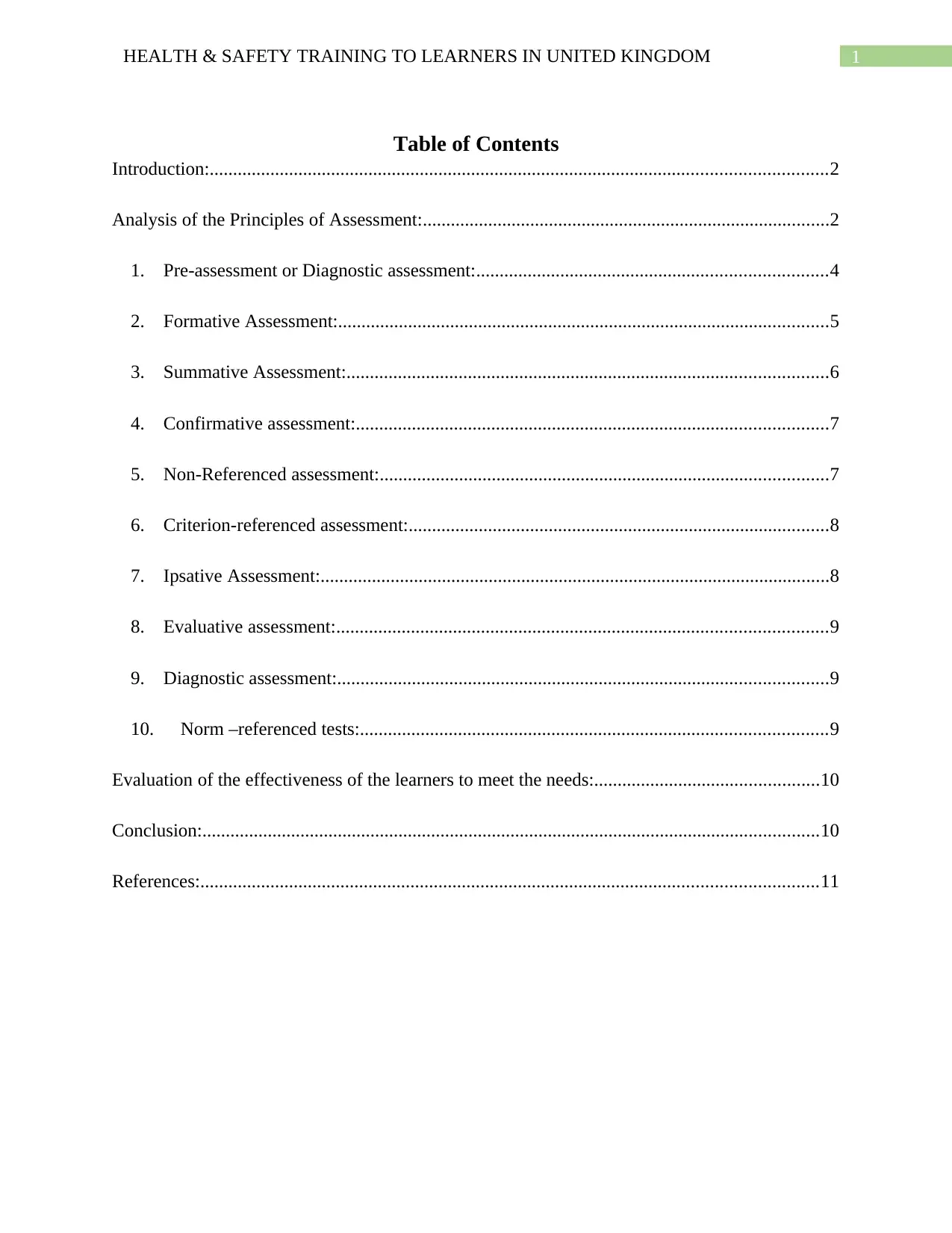
1HEALTH & SAFETY TRAINING TO LEARNERS IN UNITED KINGDOM
Table of Contents
Introduction:....................................................................................................................................2
Analysis of the Principles of Assessment:.......................................................................................2
1. Pre-assessment or Diagnostic assessment:...........................................................................4
2. Formative Assessment:.........................................................................................................5
3. Summative Assessment:.......................................................................................................6
4. Confirmative assessment:.....................................................................................................7
5. Non-Referenced assessment:................................................................................................7
6. Criterion-referenced assessment:..........................................................................................8
7. Ipsative Assessment:.............................................................................................................8
8. Evaluative assessment:.........................................................................................................9
9. Diagnostic assessment:.........................................................................................................9
10. Norm –referenced tests:....................................................................................................9
Evaluation of the effectiveness of the learners to meet the needs:................................................10
Conclusion:....................................................................................................................................10
References:....................................................................................................................................11
Table of Contents
Introduction:....................................................................................................................................2
Analysis of the Principles of Assessment:.......................................................................................2
1. Pre-assessment or Diagnostic assessment:...........................................................................4
2. Formative Assessment:.........................................................................................................5
3. Summative Assessment:.......................................................................................................6
4. Confirmative assessment:.....................................................................................................7
5. Non-Referenced assessment:................................................................................................7
6. Criterion-referenced assessment:..........................................................................................8
7. Ipsative Assessment:.............................................................................................................8
8. Evaluative assessment:.........................................................................................................9
9. Diagnostic assessment:.........................................................................................................9
10. Norm –referenced tests:....................................................................................................9
Evaluation of the effectiveness of the learners to meet the needs:................................................10
Conclusion:....................................................................................................................................10
References:....................................................................................................................................11
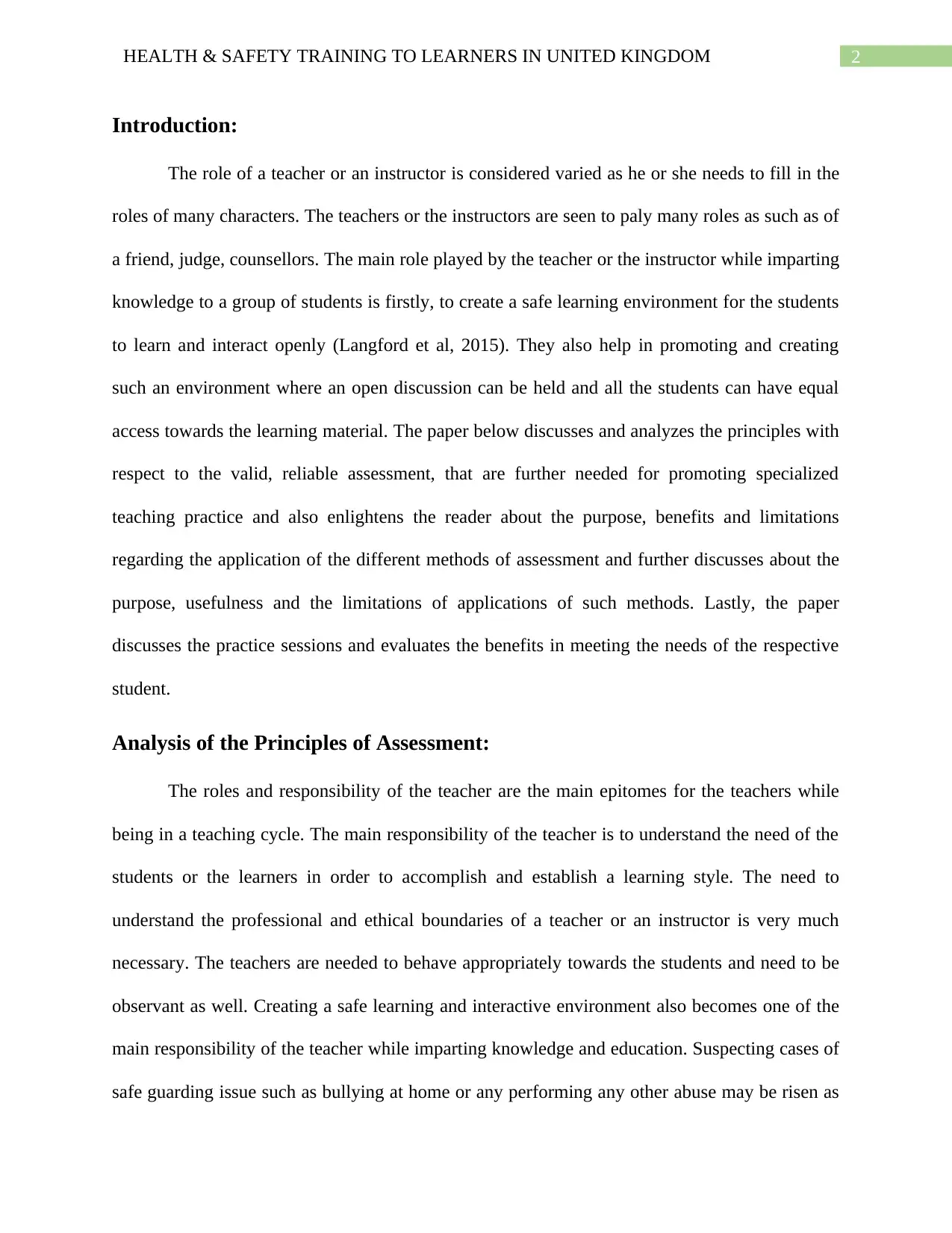
2HEALTH & SAFETY TRAINING TO LEARNERS IN UNITED KINGDOM
Introduction:
The role of a teacher or an instructor is considered varied as he or she needs to fill in the
roles of many characters. The teachers or the instructors are seen to paly many roles as such as of
a friend, judge, counsellors. The main role played by the teacher or the instructor while imparting
knowledge to a group of students is firstly, to create a safe learning environment for the students
to learn and interact openly (Langford et al, 2015). They also help in promoting and creating
such an environment where an open discussion can be held and all the students can have equal
access towards the learning material. The paper below discusses and analyzes the principles with
respect to the valid, reliable assessment, that are further needed for promoting specialized
teaching practice and also enlightens the reader about the purpose, benefits and limitations
regarding the application of the different methods of assessment and further discusses about the
purpose, usefulness and the limitations of applications of such methods. Lastly, the paper
discusses the practice sessions and evaluates the benefits in meeting the needs of the respective
student.
Analysis of the Principles of Assessment:
The roles and responsibility of the teacher are the main epitomes for the teachers while
being in a teaching cycle. The main responsibility of the teacher is to understand the need of the
students or the learners in order to accomplish and establish a learning style. The need to
understand the professional and ethical boundaries of a teacher or an instructor is very much
necessary. The teachers are needed to behave appropriately towards the students and need to be
observant as well. Creating a safe learning and interactive environment also becomes one of the
main responsibility of the teacher while imparting knowledge and education. Suspecting cases of
safe guarding issue such as bullying at home or any performing any other abuse may be risen as
Introduction:
The role of a teacher or an instructor is considered varied as he or she needs to fill in the
roles of many characters. The teachers or the instructors are seen to paly many roles as such as of
a friend, judge, counsellors. The main role played by the teacher or the instructor while imparting
knowledge to a group of students is firstly, to create a safe learning environment for the students
to learn and interact openly (Langford et al, 2015). They also help in promoting and creating
such an environment where an open discussion can be held and all the students can have equal
access towards the learning material. The paper below discusses and analyzes the principles with
respect to the valid, reliable assessment, that are further needed for promoting specialized
teaching practice and also enlightens the reader about the purpose, benefits and limitations
regarding the application of the different methods of assessment and further discusses about the
purpose, usefulness and the limitations of applications of such methods. Lastly, the paper
discusses the practice sessions and evaluates the benefits in meeting the needs of the respective
student.
Analysis of the Principles of Assessment:
The roles and responsibility of the teacher are the main epitomes for the teachers while
being in a teaching cycle. The main responsibility of the teacher is to understand the need of the
students or the learners in order to accomplish and establish a learning style. The need to
understand the professional and ethical boundaries of a teacher or an instructor is very much
necessary. The teachers are needed to behave appropriately towards the students and need to be
observant as well. Creating a safe learning and interactive environment also becomes one of the
main responsibility of the teacher while imparting knowledge and education. Suspecting cases of
safe guarding issue such as bullying at home or any performing any other abuse may be risen as
⊘ This is a preview!⊘
Do you want full access?
Subscribe today to unlock all pages.

Trusted by 1+ million students worldwide
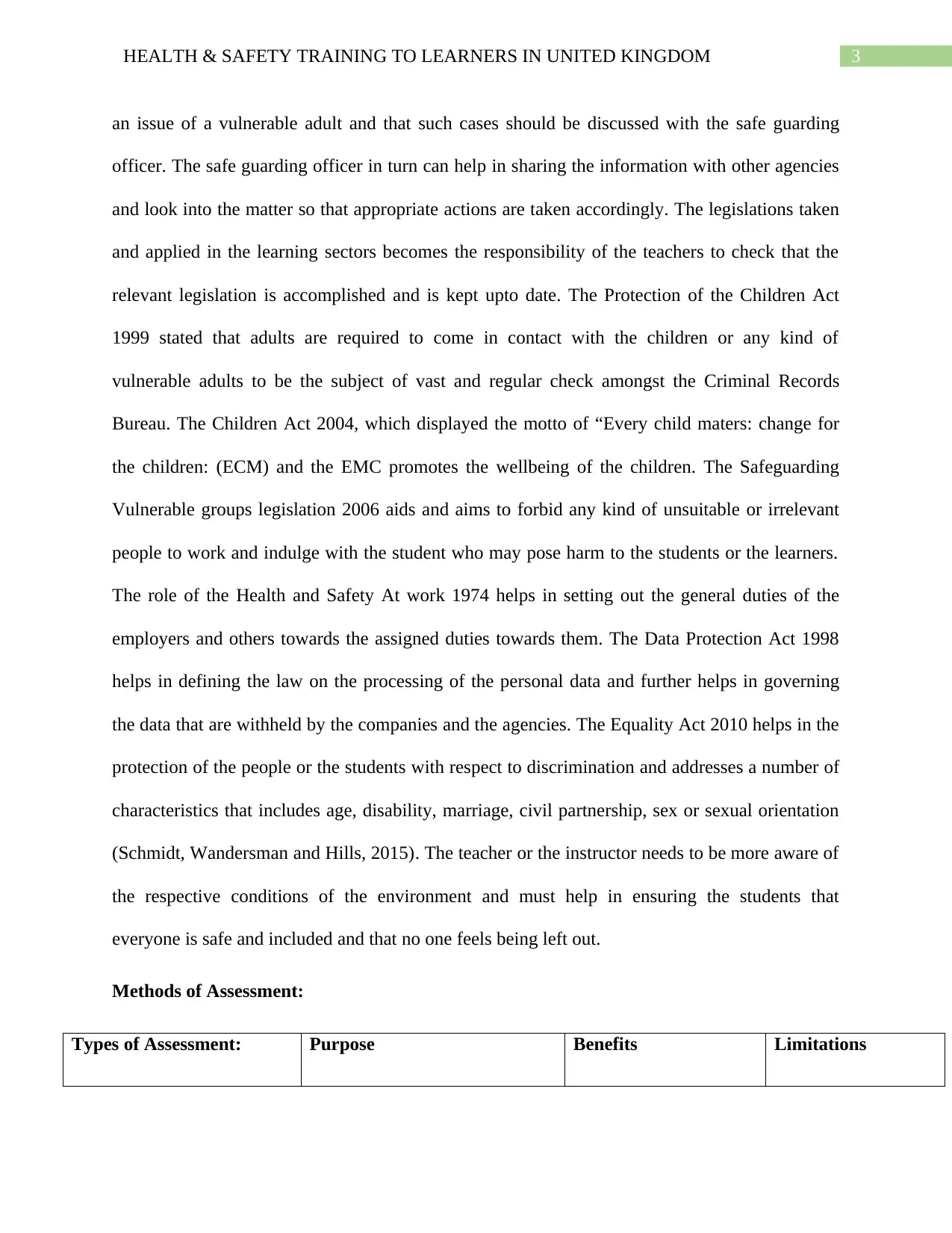
3HEALTH & SAFETY TRAINING TO LEARNERS IN UNITED KINGDOM
an issue of a vulnerable adult and that such cases should be discussed with the safe guarding
officer. The safe guarding officer in turn can help in sharing the information with other agencies
and look into the matter so that appropriate actions are taken accordingly. The legislations taken
and applied in the learning sectors becomes the responsibility of the teachers to check that the
relevant legislation is accomplished and is kept upto date. The Protection of the Children Act
1999 stated that adults are required to come in contact with the children or any kind of
vulnerable adults to be the subject of vast and regular check amongst the Criminal Records
Bureau. The Children Act 2004, which displayed the motto of “Every child maters: change for
the children: (ECM) and the EMC promotes the wellbeing of the children. The Safeguarding
Vulnerable groups legislation 2006 aids and aims to forbid any kind of unsuitable or irrelevant
people to work and indulge with the student who may pose harm to the students or the learners.
The role of the Health and Safety At work 1974 helps in setting out the general duties of the
employers and others towards the assigned duties towards them. The Data Protection Act 1998
helps in defining the law on the processing of the personal data and further helps in governing
the data that are withheld by the companies and the agencies. The Equality Act 2010 helps in the
protection of the people or the students with respect to discrimination and addresses a number of
characteristics that includes age, disability, marriage, civil partnership, sex or sexual orientation
(Schmidt, Wandersman and Hills, 2015). The teacher or the instructor needs to be more aware of
the respective conditions of the environment and must help in ensuring the students that
everyone is safe and included and that no one feels being left out.
Methods of Assessment:
Types of Assessment: Purpose Benefits Limitations
an issue of a vulnerable adult and that such cases should be discussed with the safe guarding
officer. The safe guarding officer in turn can help in sharing the information with other agencies
and look into the matter so that appropriate actions are taken accordingly. The legislations taken
and applied in the learning sectors becomes the responsibility of the teachers to check that the
relevant legislation is accomplished and is kept upto date. The Protection of the Children Act
1999 stated that adults are required to come in contact with the children or any kind of
vulnerable adults to be the subject of vast and regular check amongst the Criminal Records
Bureau. The Children Act 2004, which displayed the motto of “Every child maters: change for
the children: (ECM) and the EMC promotes the wellbeing of the children. The Safeguarding
Vulnerable groups legislation 2006 aids and aims to forbid any kind of unsuitable or irrelevant
people to work and indulge with the student who may pose harm to the students or the learners.
The role of the Health and Safety At work 1974 helps in setting out the general duties of the
employers and others towards the assigned duties towards them. The Data Protection Act 1998
helps in defining the law on the processing of the personal data and further helps in governing
the data that are withheld by the companies and the agencies. The Equality Act 2010 helps in the
protection of the people or the students with respect to discrimination and addresses a number of
characteristics that includes age, disability, marriage, civil partnership, sex or sexual orientation
(Schmidt, Wandersman and Hills, 2015). The teacher or the instructor needs to be more aware of
the respective conditions of the environment and must help in ensuring the students that
everyone is safe and included and that no one feels being left out.
Methods of Assessment:
Types of Assessment: Purpose Benefits Limitations
Paraphrase This Document
Need a fresh take? Get an instant paraphrase of this document with our AI Paraphraser
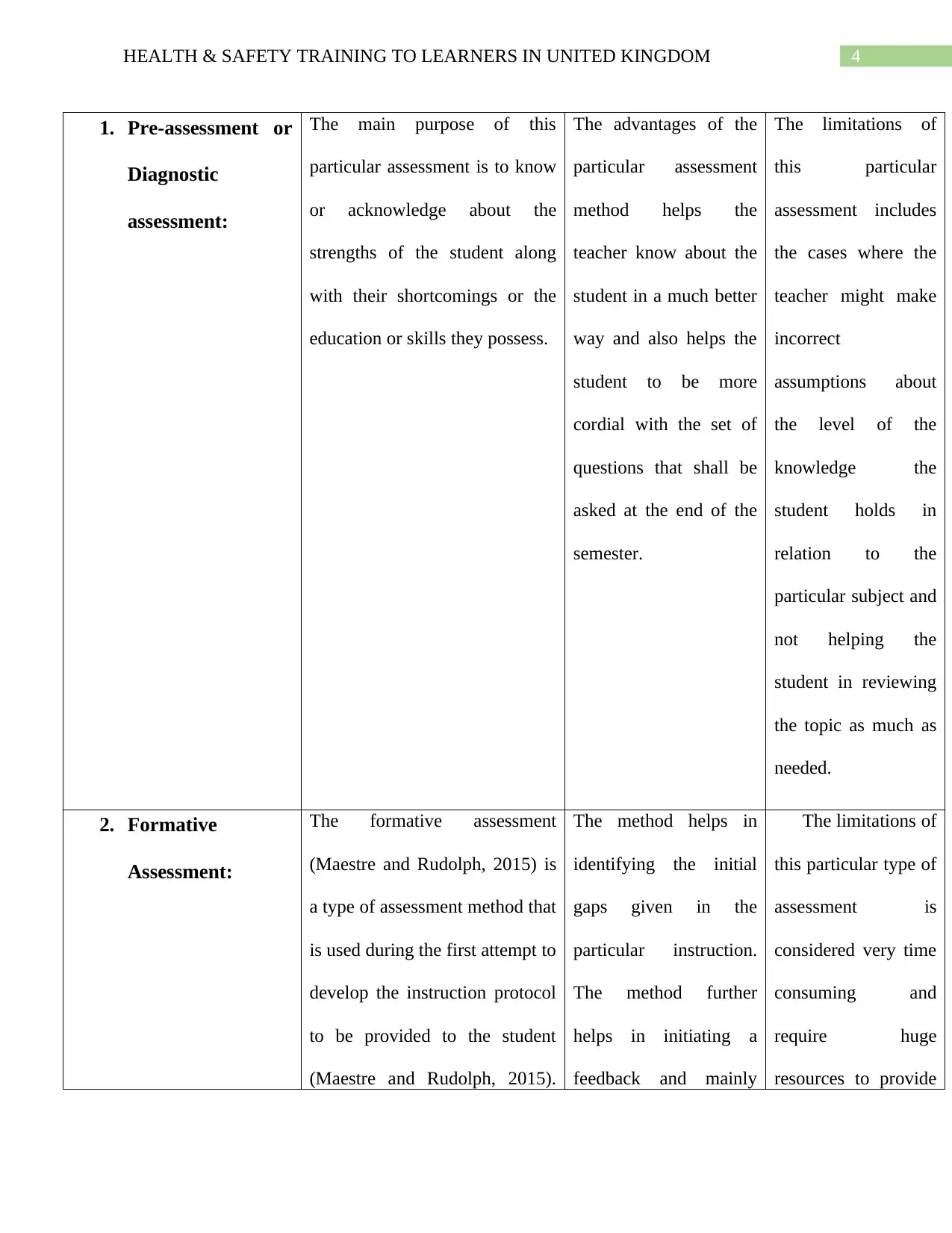
4HEALTH & SAFETY TRAINING TO LEARNERS IN UNITED KINGDOM
1. Pre-assessment or
Diagnostic
assessment:
The main purpose of this
particular assessment is to know
or acknowledge about the
strengths of the student along
with their shortcomings or the
education or skills they possess.
The advantages of the
particular assessment
method helps the
teacher know about the
student in a much better
way and also helps the
student to be more
cordial with the set of
questions that shall be
asked at the end of the
semester.
The limitations of
this particular
assessment includes
the cases where the
teacher might make
incorrect
assumptions about
the level of the
knowledge the
student holds in
relation to the
particular subject and
not helping the
student in reviewing
the topic as much as
needed.
2. Formative
Assessment:
The formative assessment
(Maestre and Rudolph, 2015) is
a type of assessment method that
is used during the first attempt to
develop the instruction protocol
to be provided to the student
(Maestre and Rudolph, 2015).
The method helps in
identifying the initial
gaps given in the
particular instruction.
The method further
helps in initiating a
feedback and mainly
The limitations of
this particular type of
assessment is
considered very time
consuming and
require huge
resources to provide
1. Pre-assessment or
Diagnostic
assessment:
The main purpose of this
particular assessment is to know
or acknowledge about the
strengths of the student along
with their shortcomings or the
education or skills they possess.
The advantages of the
particular assessment
method helps the
teacher know about the
student in a much better
way and also helps the
student to be more
cordial with the set of
questions that shall be
asked at the end of the
semester.
The limitations of
this particular
assessment includes
the cases where the
teacher might make
incorrect
assumptions about
the level of the
knowledge the
student holds in
relation to the
particular subject and
not helping the
student in reviewing
the topic as much as
needed.
2. Formative
Assessment:
The formative assessment
(Maestre and Rudolph, 2015) is
a type of assessment method that
is used during the first attempt to
develop the instruction protocol
to be provided to the student
(Maestre and Rudolph, 2015).
The method helps in
identifying the initial
gaps given in the
particular instruction.
The method further
helps in initiating a
feedback and mainly
The limitations of
this particular type of
assessment is
considered very time
consuming and
require huge
resources to provide
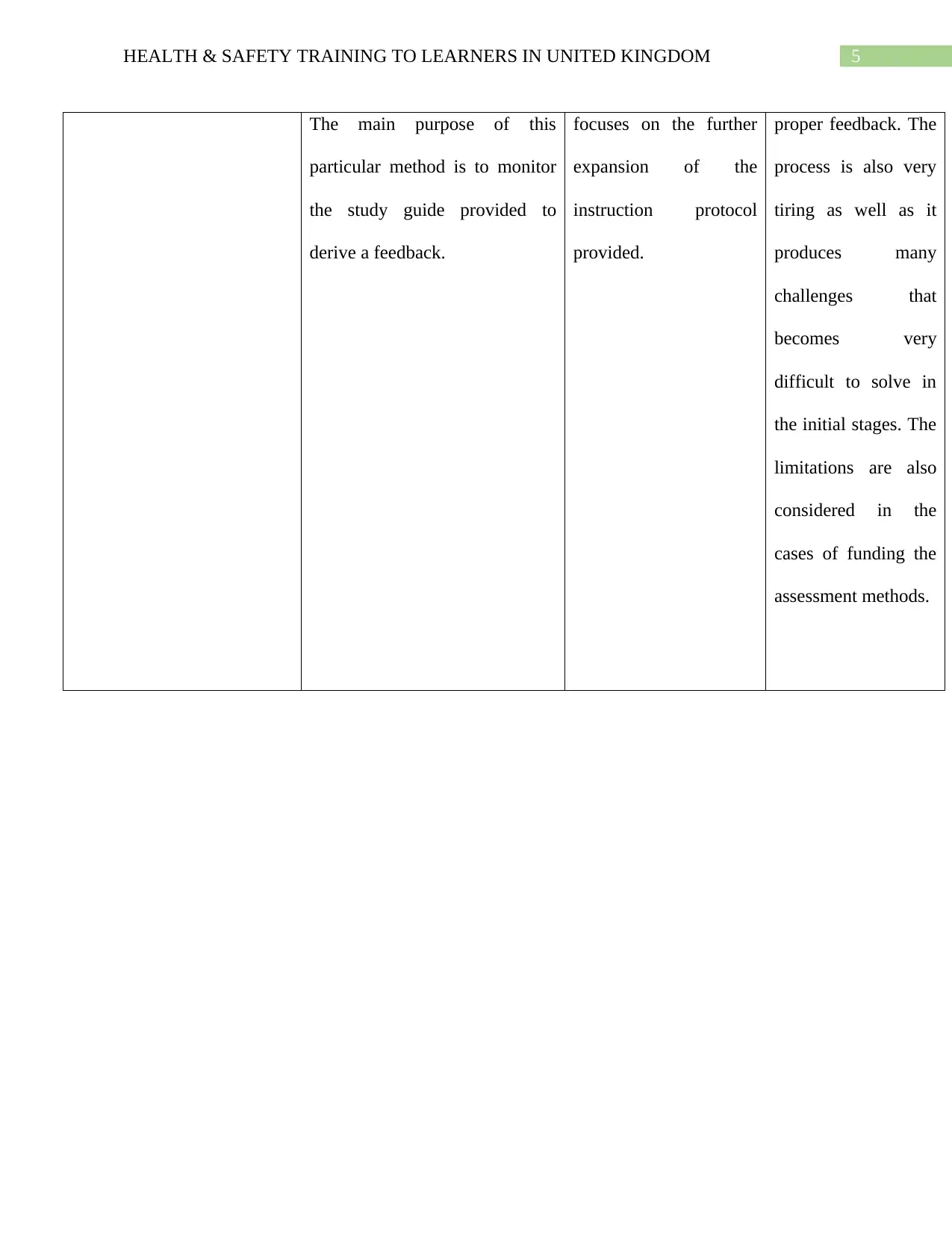
5HEALTH & SAFETY TRAINING TO LEARNERS IN UNITED KINGDOM
The main purpose of this
particular method is to monitor
the study guide provided to
derive a feedback.
focuses on the further
expansion of the
instruction protocol
provided.
proper feedback. The
process is also very
tiring as well as it
produces many
challenges that
becomes very
difficult to solve in
the initial stages. The
limitations are also
considered in the
cases of funding the
assessment methods.
The main purpose of this
particular method is to monitor
the study guide provided to
derive a feedback.
focuses on the further
expansion of the
instruction protocol
provided.
proper feedback. The
process is also very
tiring as well as it
produces many
challenges that
becomes very
difficult to solve in
the initial stages. The
limitations are also
considered in the
cases of funding the
assessment methods.
⊘ This is a preview!⊘
Do you want full access?
Subscribe today to unlock all pages.

Trusted by 1+ million students worldwide
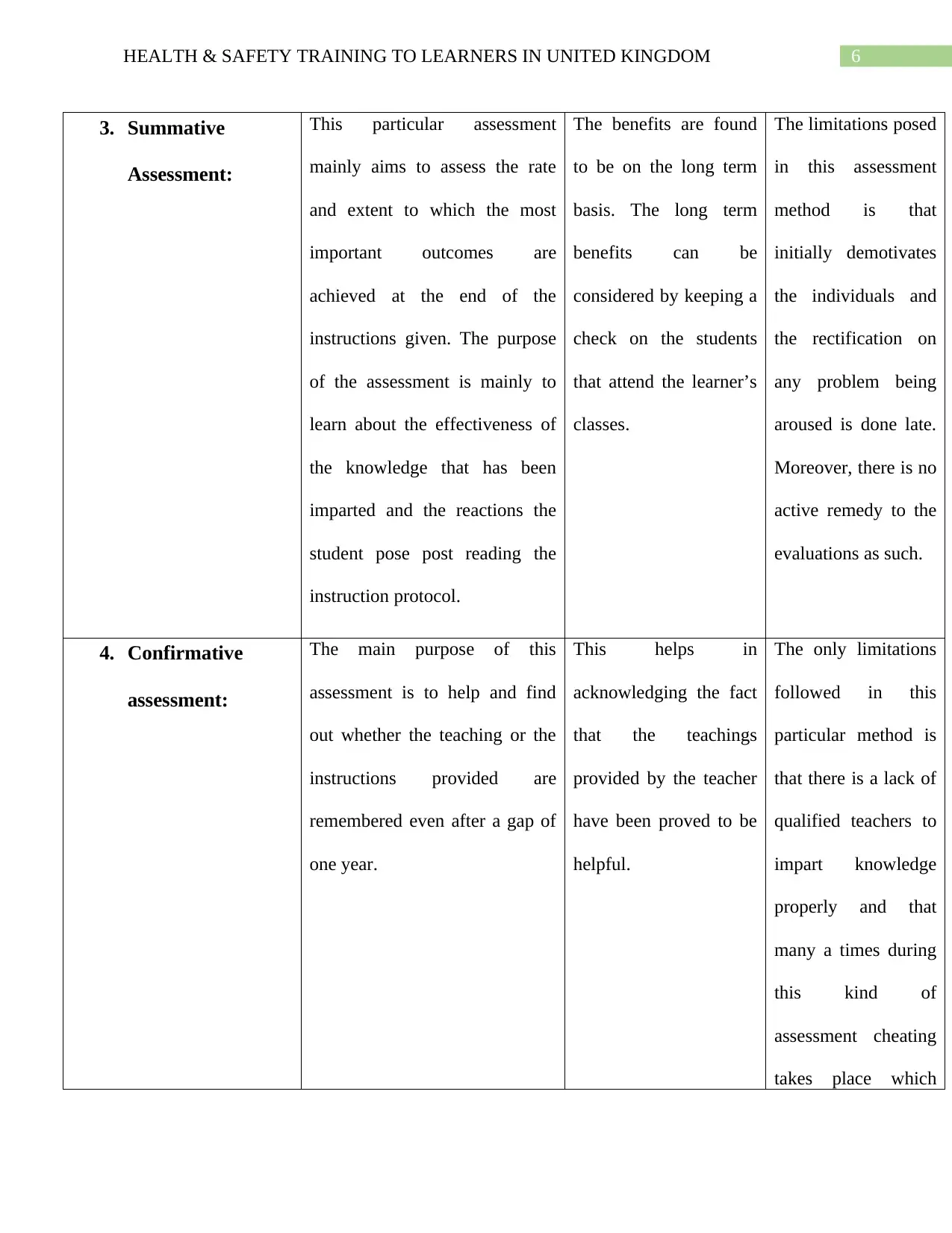
6HEALTH & SAFETY TRAINING TO LEARNERS IN UNITED KINGDOM
3. Summative
Assessment:
This particular assessment
mainly aims to assess the rate
and extent to which the most
important outcomes are
achieved at the end of the
instructions given. The purpose
of the assessment is mainly to
learn about the effectiveness of
the knowledge that has been
imparted and the reactions the
student pose post reading the
instruction protocol.
The benefits are found
to be on the long term
basis. The long term
benefits can be
considered by keeping a
check on the students
that attend the learner’s
classes.
The limitations posed
in this assessment
method is that
initially demotivates
the individuals and
the rectification on
any problem being
aroused is done late.
Moreover, there is no
active remedy to the
evaluations as such.
4. Confirmative
assessment:
The main purpose of this
assessment is to help and find
out whether the teaching or the
instructions provided are
remembered even after a gap of
one year.
This helps in
acknowledging the fact
that the teachings
provided by the teacher
have been proved to be
helpful.
The only limitations
followed in this
particular method is
that there is a lack of
qualified teachers to
impart knowledge
properly and that
many a times during
this kind of
assessment cheating
takes place which
3. Summative
Assessment:
This particular assessment
mainly aims to assess the rate
and extent to which the most
important outcomes are
achieved at the end of the
instructions given. The purpose
of the assessment is mainly to
learn about the effectiveness of
the knowledge that has been
imparted and the reactions the
student pose post reading the
instruction protocol.
The benefits are found
to be on the long term
basis. The long term
benefits can be
considered by keeping a
check on the students
that attend the learner’s
classes.
The limitations posed
in this assessment
method is that
initially demotivates
the individuals and
the rectification on
any problem being
aroused is done late.
Moreover, there is no
active remedy to the
evaluations as such.
4. Confirmative
assessment:
The main purpose of this
assessment is to help and find
out whether the teaching or the
instructions provided are
remembered even after a gap of
one year.
This helps in
acknowledging the fact
that the teachings
provided by the teacher
have been proved to be
helpful.
The only limitations
followed in this
particular method is
that there is a lack of
qualified teachers to
impart knowledge
properly and that
many a times during
this kind of
assessment cheating
takes place which
Paraphrase This Document
Need a fresh take? Get an instant paraphrase of this document with our AI Paraphraser
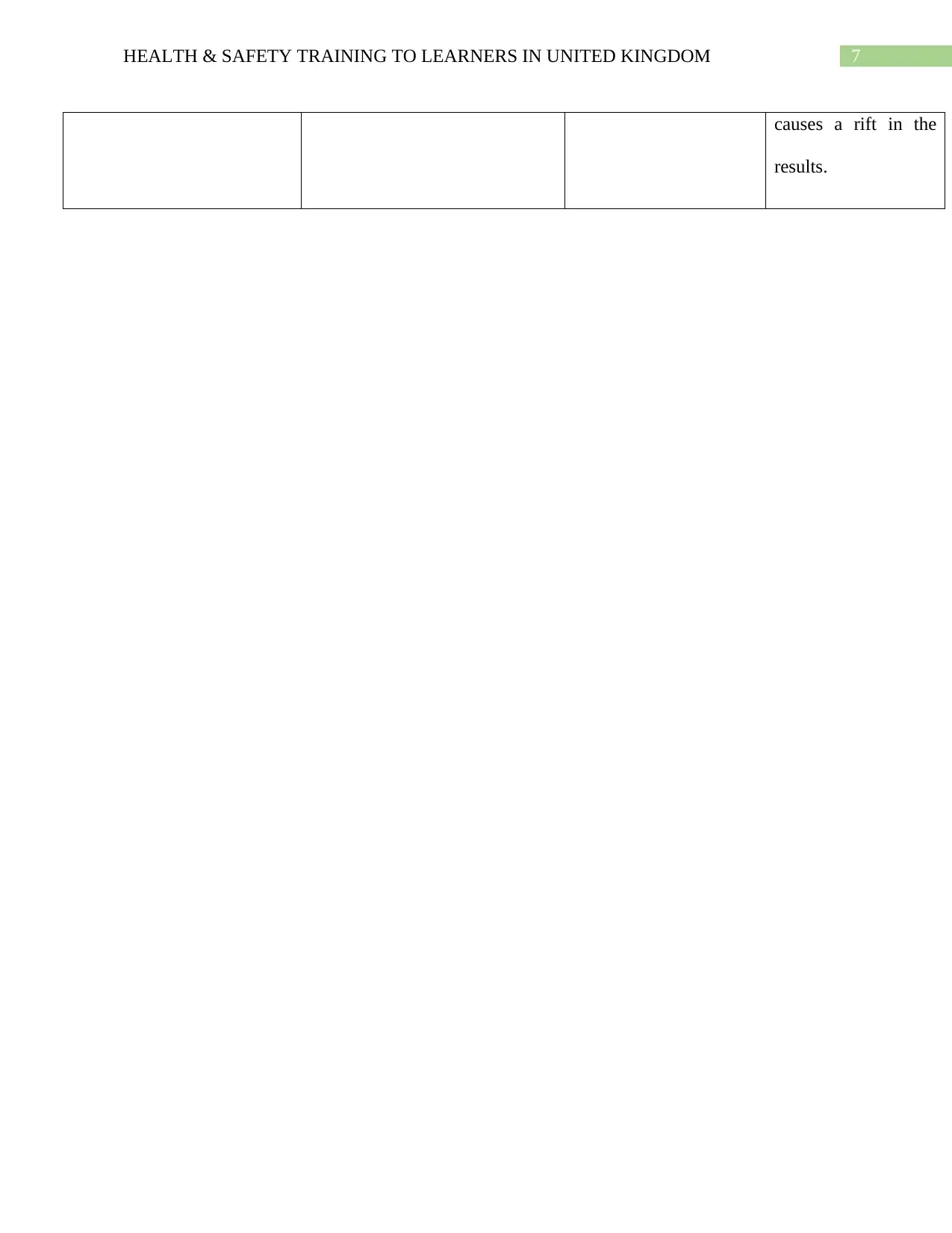
7HEALTH & SAFETY TRAINING TO LEARNERS IN UNITED KINGDOM
causes a rift in the
results.
causes a rift in the
results.
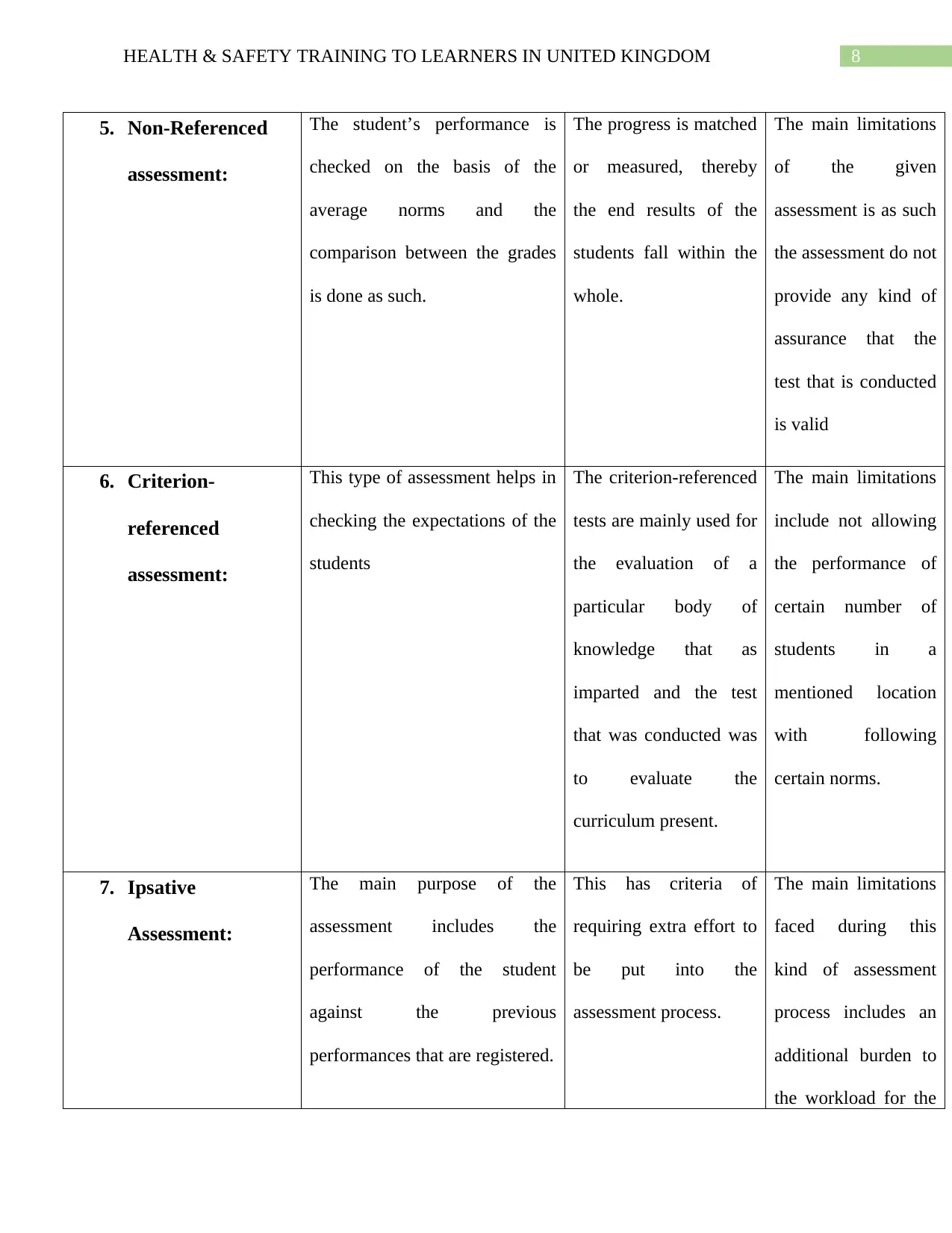
8HEALTH & SAFETY TRAINING TO LEARNERS IN UNITED KINGDOM
5. Non-Referenced
assessment:
The student’s performance is
checked on the basis of the
average norms and the
comparison between the grades
is done as such.
The progress is matched
or measured, thereby
the end results of the
students fall within the
whole.
The main limitations
of the given
assessment is as such
the assessment do not
provide any kind of
assurance that the
test that is conducted
is valid
6. Criterion-
referenced
assessment:
This type of assessment helps in
checking the expectations of the
students
The criterion-referenced
tests are mainly used for
the evaluation of a
particular body of
knowledge that as
imparted and the test
that was conducted was
to evaluate the
curriculum present.
The main limitations
include not allowing
the performance of
certain number of
students in a
mentioned location
with following
certain norms.
7. Ipsative
Assessment:
The main purpose of the
assessment includes the
performance of the student
against the previous
performances that are registered.
This has criteria of
requiring extra effort to
be put into the
assessment process.
The main limitations
faced during this
kind of assessment
process includes an
additional burden to
the workload for the
5. Non-Referenced
assessment:
The student’s performance is
checked on the basis of the
average norms and the
comparison between the grades
is done as such.
The progress is matched
or measured, thereby
the end results of the
students fall within the
whole.
The main limitations
of the given
assessment is as such
the assessment do not
provide any kind of
assurance that the
test that is conducted
is valid
6. Criterion-
referenced
assessment:
This type of assessment helps in
checking the expectations of the
students
The criterion-referenced
tests are mainly used for
the evaluation of a
particular body of
knowledge that as
imparted and the test
that was conducted was
to evaluate the
curriculum present.
The main limitations
include not allowing
the performance of
certain number of
students in a
mentioned location
with following
certain norms.
7. Ipsative
Assessment:
The main purpose of the
assessment includes the
performance of the student
against the previous
performances that are registered.
This has criteria of
requiring extra effort to
be put into the
assessment process.
The main limitations
faced during this
kind of assessment
process includes an
additional burden to
the workload for the
⊘ This is a preview!⊘
Do you want full access?
Subscribe today to unlock all pages.

Trusted by 1+ million students worldwide
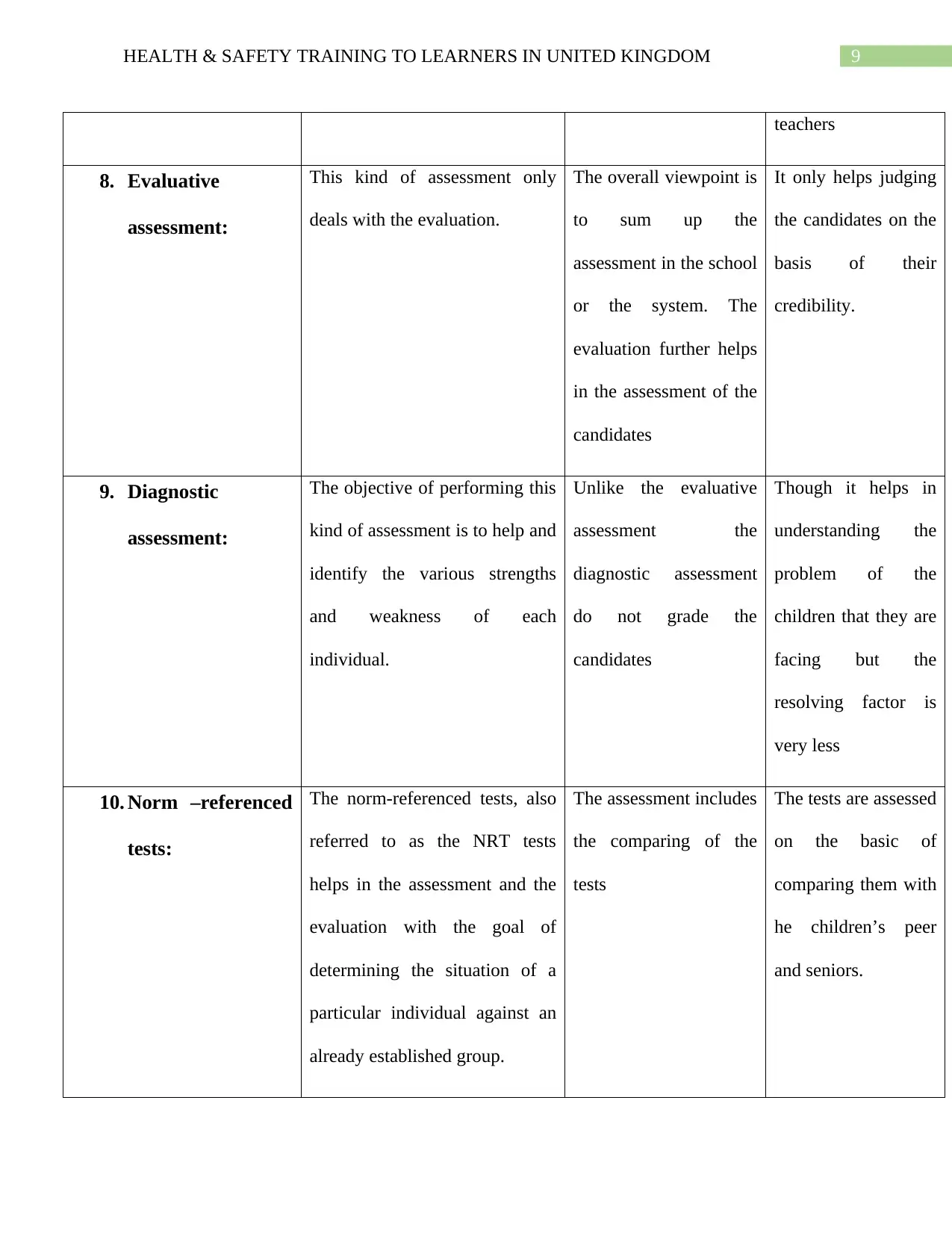
9HEALTH & SAFETY TRAINING TO LEARNERS IN UNITED KINGDOM
teachers
8. Evaluative
assessment:
This kind of assessment only
deals with the evaluation.
The overall viewpoint is
to sum up the
assessment in the school
or the system. The
evaluation further helps
in the assessment of the
candidates
It only helps judging
the candidates on the
basis of their
credibility.
9. Diagnostic
assessment:
The objective of performing this
kind of assessment is to help and
identify the various strengths
and weakness of each
individual.
Unlike the evaluative
assessment the
diagnostic assessment
do not grade the
candidates
Though it helps in
understanding the
problem of the
children that they are
facing but the
resolving factor is
very less
10. Norm –referenced
tests:
The norm-referenced tests, also
referred to as the NRT tests
helps in the assessment and the
evaluation with the goal of
determining the situation of a
particular individual against an
already established group.
The assessment includes
the comparing of the
tests
The tests are assessed
on the basic of
comparing them with
he children’s peer
and seniors.
teachers
8. Evaluative
assessment:
This kind of assessment only
deals with the evaluation.
The overall viewpoint is
to sum up the
assessment in the school
or the system. The
evaluation further helps
in the assessment of the
candidates
It only helps judging
the candidates on the
basis of their
credibility.
9. Diagnostic
assessment:
The objective of performing this
kind of assessment is to help and
identify the various strengths
and weakness of each
individual.
Unlike the evaluative
assessment the
diagnostic assessment
do not grade the
candidates
Though it helps in
understanding the
problem of the
children that they are
facing but the
resolving factor is
very less
10. Norm –referenced
tests:
The norm-referenced tests, also
referred to as the NRT tests
helps in the assessment and the
evaluation with the goal of
determining the situation of a
particular individual against an
already established group.
The assessment includes
the comparing of the
tests
The tests are assessed
on the basic of
comparing them with
he children’s peer
and seniors.
Paraphrase This Document
Need a fresh take? Get an instant paraphrase of this document with our AI Paraphraser
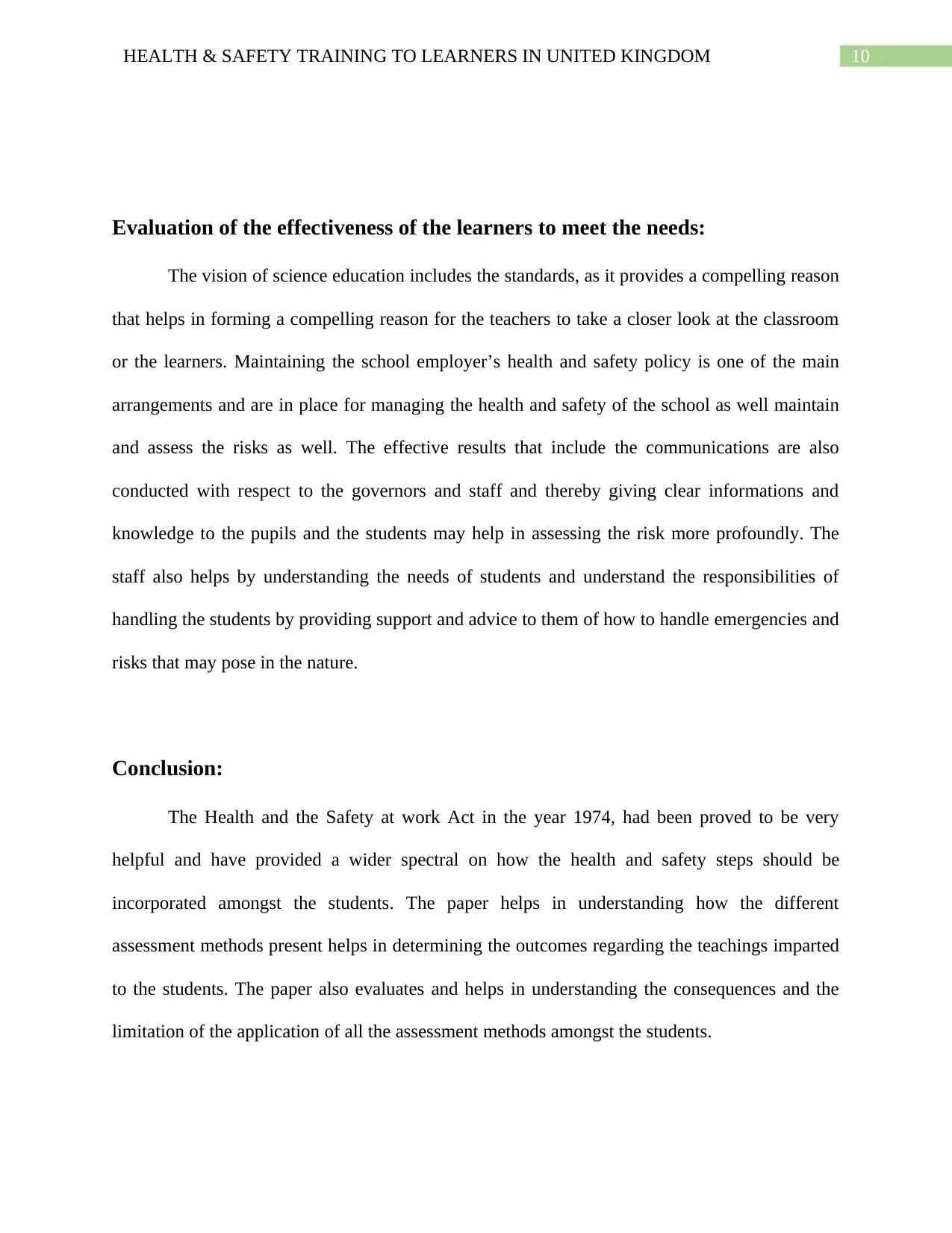
10HEALTH & SAFETY TRAINING TO LEARNERS IN UNITED KINGDOM
Evaluation of the effectiveness of the learners to meet the needs:
The vision of science education includes the standards, as it provides a compelling reason
that helps in forming a compelling reason for the teachers to take a closer look at the classroom
or the learners. Maintaining the school employer’s health and safety policy is one of the main
arrangements and are in place for managing the health and safety of the school as well maintain
and assess the risks as well. The effective results that include the communications are also
conducted with respect to the governors and staff and thereby giving clear informations and
knowledge to the pupils and the students may help in assessing the risk more profoundly. The
staff also helps by understanding the needs of students and understand the responsibilities of
handling the students by providing support and advice to them of how to handle emergencies and
risks that may pose in the nature.
Conclusion:
The Health and the Safety at work Act in the year 1974, had been proved to be very
helpful and have provided a wider spectral on how the health and safety steps should be
incorporated amongst the students. The paper helps in understanding how the different
assessment methods present helps in determining the outcomes regarding the teachings imparted
to the students. The paper also evaluates and helps in understanding the consequences and the
limitation of the application of all the assessment methods amongst the students.
Evaluation of the effectiveness of the learners to meet the needs:
The vision of science education includes the standards, as it provides a compelling reason
that helps in forming a compelling reason for the teachers to take a closer look at the classroom
or the learners. Maintaining the school employer’s health and safety policy is one of the main
arrangements and are in place for managing the health and safety of the school as well maintain
and assess the risks as well. The effective results that include the communications are also
conducted with respect to the governors and staff and thereby giving clear informations and
knowledge to the pupils and the students may help in assessing the risk more profoundly. The
staff also helps by understanding the needs of students and understand the responsibilities of
handling the students by providing support and advice to them of how to handle emergencies and
risks that may pose in the nature.
Conclusion:
The Health and the Safety at work Act in the year 1974, had been proved to be very
helpful and have provided a wider spectral on how the health and safety steps should be
incorporated amongst the students. The paper helps in understanding how the different
assessment methods present helps in determining the outcomes regarding the teachings imparted
to the students. The paper also evaluates and helps in understanding the consequences and the
limitation of the application of all the assessment methods amongst the students.
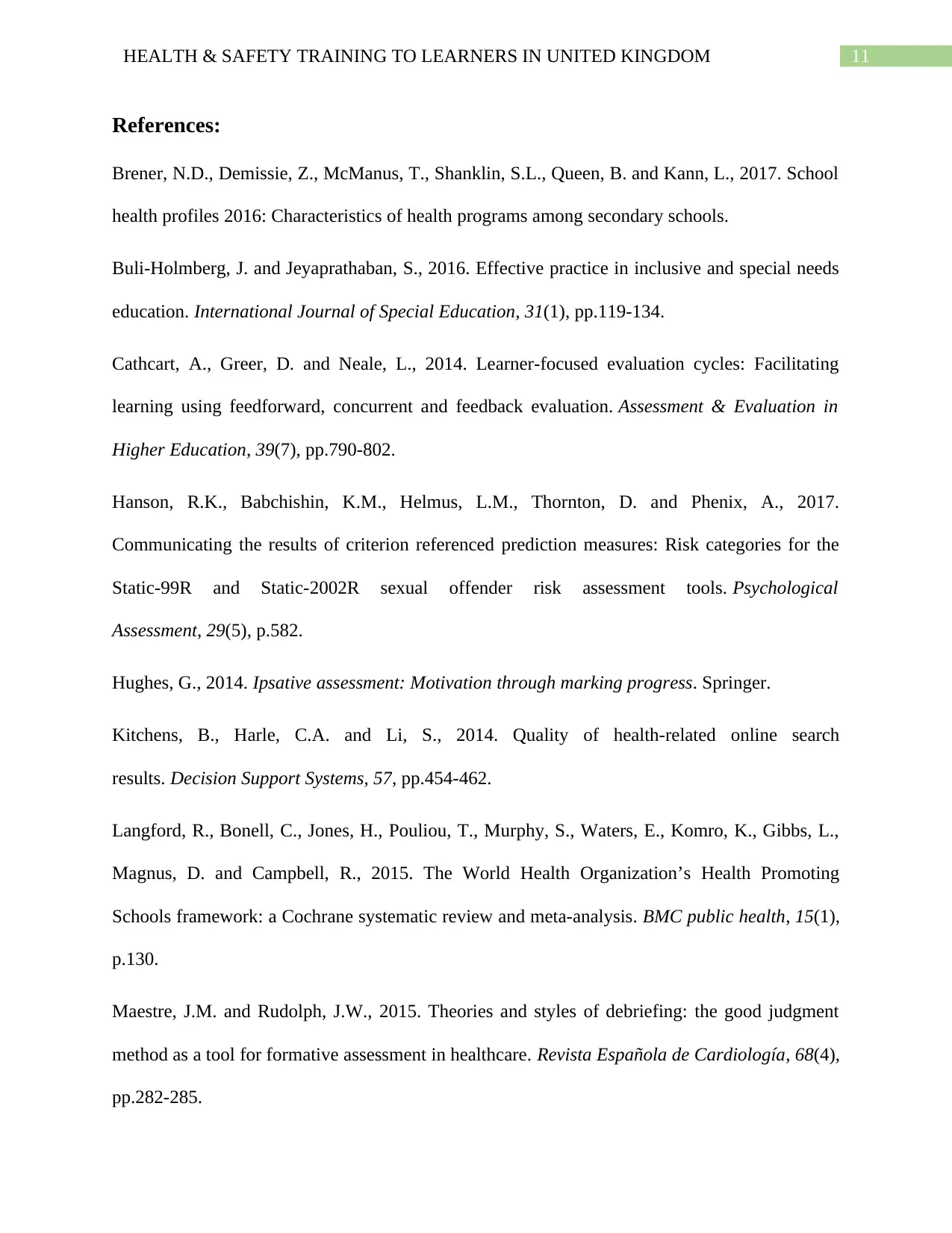
11HEALTH & SAFETY TRAINING TO LEARNERS IN UNITED KINGDOM
References:
Brener, N.D., Demissie, Z., McManus, T., Shanklin, S.L., Queen, B. and Kann, L., 2017. School
health profiles 2016: Characteristics of health programs among secondary schools.
Buli-Holmberg, J. and Jeyaprathaban, S., 2016. Effective practice in inclusive and special needs
education. International Journal of Special Education, 31(1), pp.119-134.
Cathcart, A., Greer, D. and Neale, L., 2014. Learner-focused evaluation cycles: Facilitating
learning using feedforward, concurrent and feedback evaluation. Assessment & Evaluation in
Higher Education, 39(7), pp.790-802.
Hanson, R.K., Babchishin, K.M., Helmus, L.M., Thornton, D. and Phenix, A., 2017.
Communicating the results of criterion referenced prediction measures: Risk categories for the
Static-99R and Static-2002R sexual offender risk assessment tools. Psychological
Assessment, 29(5), p.582.
Hughes, G., 2014. Ipsative assessment: Motivation through marking progress. Springer.
Kitchens, B., Harle, C.A. and Li, S., 2014. Quality of health-related online search
results. Decision Support Systems, 57, pp.454-462.
Langford, R., Bonell, C., Jones, H., Pouliou, T., Murphy, S., Waters, E., Komro, K., Gibbs, L.,
Magnus, D. and Campbell, R., 2015. The World Health Organization’s Health Promoting
Schools framework: a Cochrane systematic review and meta-analysis. BMC public health, 15(1),
p.130.
Maestre, J.M. and Rudolph, J.W., 2015. Theories and styles of debriefing: the good judgment
method as a tool for formative assessment in healthcare. Revista Española de Cardiología, 68(4),
pp.282-285.
References:
Brener, N.D., Demissie, Z., McManus, T., Shanklin, S.L., Queen, B. and Kann, L., 2017. School
health profiles 2016: Characteristics of health programs among secondary schools.
Buli-Holmberg, J. and Jeyaprathaban, S., 2016. Effective practice in inclusive and special needs
education. International Journal of Special Education, 31(1), pp.119-134.
Cathcart, A., Greer, D. and Neale, L., 2014. Learner-focused evaluation cycles: Facilitating
learning using feedforward, concurrent and feedback evaluation. Assessment & Evaluation in
Higher Education, 39(7), pp.790-802.
Hanson, R.K., Babchishin, K.M., Helmus, L.M., Thornton, D. and Phenix, A., 2017.
Communicating the results of criterion referenced prediction measures: Risk categories for the
Static-99R and Static-2002R sexual offender risk assessment tools. Psychological
Assessment, 29(5), p.582.
Hughes, G., 2014. Ipsative assessment: Motivation through marking progress. Springer.
Kitchens, B., Harle, C.A. and Li, S., 2014. Quality of health-related online search
results. Decision Support Systems, 57, pp.454-462.
Langford, R., Bonell, C., Jones, H., Pouliou, T., Murphy, S., Waters, E., Komro, K., Gibbs, L.,
Magnus, D. and Campbell, R., 2015. The World Health Organization’s Health Promoting
Schools framework: a Cochrane systematic review and meta-analysis. BMC public health, 15(1),
p.130.
Maestre, J.M. and Rudolph, J.W., 2015. Theories and styles of debriefing: the good judgment
method as a tool for formative assessment in healthcare. Revista Española de Cardiología, 68(4),
pp.282-285.
⊘ This is a preview!⊘
Do you want full access?
Subscribe today to unlock all pages.

Trusted by 1+ million students worldwide
1 out of 13
Related Documents
Your All-in-One AI-Powered Toolkit for Academic Success.
+13062052269
info@desklib.com
Available 24*7 on WhatsApp / Email
![[object Object]](/_next/static/media/star-bottom.7253800d.svg)
Unlock your academic potential
Copyright © 2020–2025 A2Z Services. All Rights Reserved. Developed and managed by ZUCOL.



